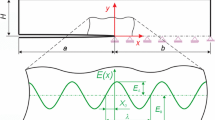Abstract
In order to increase the accuracy of stressintensity-factor measurements and to obtain data on additional parameters which may influence fracture behavior (such as crack branching and crack curvature) a technique for fullfield fringe-pattern analysis (referred to as the local collocation method) has been developed. This method removes the restriction of limiting the data analysis region to the near-field region by including additional nonsingular terms in the algorithm. In this paper the theory of the method is developed and sample results using photoelastic, holographic and moiré full-field patterns are provided.
Similar content being viewed by others
References
Wells, A. andPost, D., “The Dynamic Stress Distribution Surrounding a Running Crack—A Photoelastic Analysis,”Proc. SESA,16 (1),69–92 (1958).
Cranz, C. andSchardin, H., “Kinematographic auf ru hendem film und mit extrem hoher bildfrequenz,”Zeit. f. Phys.,56,147 (1929).
Dally, J.W., “Dynamic Photoelastic Studies of Fracture,” William M. Murray Lecture,Experimental Mechanics,19 (10),349–362 (1979).
Irwin, G.R., Discussion of Ref. 1, Proc. SESA,16 (1),93–96 (1958).
Sih, G.C., “On the Westergaard Method of Crack Analysis,”Int. J. Fract. Mech.,2,628 (1966).
Eftis, J. andLiebowitz, H., “On the Modified Westergaard Equations for Certain Crack Problems,”Int. J. Fract. Mech.,8 (4),383–392 (1972).
Larsson, S.G. andCarlsson, A.J., “Influence of Non-singular Stress Terms and Specimen Geometry on Small-scale Yielding at Crack Tips in Elastic-plastic Materials,”J. Mech. Phys. Solids,21,263–277 (1973).
Sanford, R.J., “A Critical Re-examination of the Westergaard Method Solving Opening Mode Crack Problems,”Mech. Res. Comm.,6,289–294 (1979).
Bradley, W.B. andKobayashi, A.S., “An Investigation of Propagating Cracks by Dynamic Photoelasticity,”Experimental Mechanics,10 (3),106–113 (March 1970).
Kobayashi, T. andDally, J.W., “The Relation Between Crack Velocity and the Stress Intensity Factor in Birefringent Polymers,”ASTM STP 627, 257–273 (1977).
Dally, J. W. andKobayashi, T., “Crack Arrest in Duplex Specimens,”Int. J. Solids, Struct.,14,121–129 (1978).
Smith, C.W., “Use of Three-dimensional Photoelasticity in Fracture Mechanics,”Experimental Mechanics,13, (12),539–544 (1973).
Schroedl, M.A., McGowan, J.J. andSmith, C.W., “Determination of Stress Intensity Factors from Photoelastic Data with Application to Surface Flaw Problems,”Experimental Mechanics,14 (10)392–399 (1974).
Smith, C.W., “Photoelasticity in Fracture Mechanics,”Experimental Mechanics,20 (11),390–396 (1980).
Smith, C.W., Post, D., Hiatt, G. andNicoletto, G., “Displacement Measurements Around Cracks in Three-dimensional Problems by a Hybrid Experimental Technique,”Experimental Mechanics,23 (1),15–20 (1983).
Sanford, R.J., andDally, J.W., “A General Method for Determining Mixed-Mode Stress Intensity Factors from Isochromatic Fringe Patterns,”Eng. Fract. Mech.,11,621–633 (1979).
Parks, V.J., Sanford, R.J. and Dally, J.W., “Optical Fracture Mechanics and Stress Analysis of a Turbine Engine Fan Disk,” CASE STUDIES ON STRUCTURAL INTEGRITY AND RELIABILITY, Proc. Army Symp. on Solid Mech., 113–131 (Sept. 1978).
Dudderar, T.D. andGorman, H.J., “The Determination of Mode I Stress-intensity Factors by Holographic Interferometry,”Experimental Mechanics,13 (4),145–149 (1973).
Schroedl, M.A. andSmith, C.W., “A Study of Near and Far Field Effects in Photoelastic Stress Intensity Determination,”Eng. Fract. Mech.,7,341–355 (1975).
Rosakis, A.J. andRavi-Chandar, K., “On Crack Tip Stress State: An Experimental Evaluation of Three-dimensional Effects,”Int. J. Solids and Struct.,22 (2),121–134 (1986).
Chona, R., Irwin, G.R. andSanford, R.J., “Influence of Specimen Size and Shape on the Singularity Dominated Zone,”ASTM 791, 13–123 (1983).
Sanford, R.J., “Application of the Least Squares Method to Photoelastic Analysis,”Experimental Mechanics,20,192–197 (1980).
Sanford, R.J. andChona, R., “Photoelastic Calibration of the Short Bar Chevron-notch Specimen,”ASTM STP, 855, 81–97 (1984).
Barker, D.B., Sanford, R.J. andChona, R., “Determining K and Related Stress-Field Parameters from Displacement Fields,”Experimental Mechanics,25 (12),399–407 (1985).
Williams, M.L., “On the Stress State at the Base of a Stationary Crack,”J. Appl. Mech.,24,109–114 (March 1957).
Sanford, R.J. and Berger, J.R., “The Numerical Solution of Opening Mode Finite Body Fracture Problems Using Generalized Westergaard Functions,” Eng. Fract. Mech., in press.
Chona, R. and Sanford, R.J., “Analyzing Crack Tip Isochromatic Fringe Patterns,” VI Int. Cong. on Exp. Mech. (1988).
Chona, R., “The Stress Field Surrounding the Tip of a Crack Propagating in a Finite Body,”PhD Diss., Univ. of Maryland, College Park, MD 1987.
Author information
Authors and Affiliations
Rights and permissions
About this article
Cite this article
Sanford, R.J. Determining fracture parameters with full-field optical methods. Experimental Mechanics 29, 241–247 (1989). https://doi.org/10.1007/BF02321401
Received:
Revised:
Issue Date:
DOI: https://doi.org/10.1007/BF02321401




